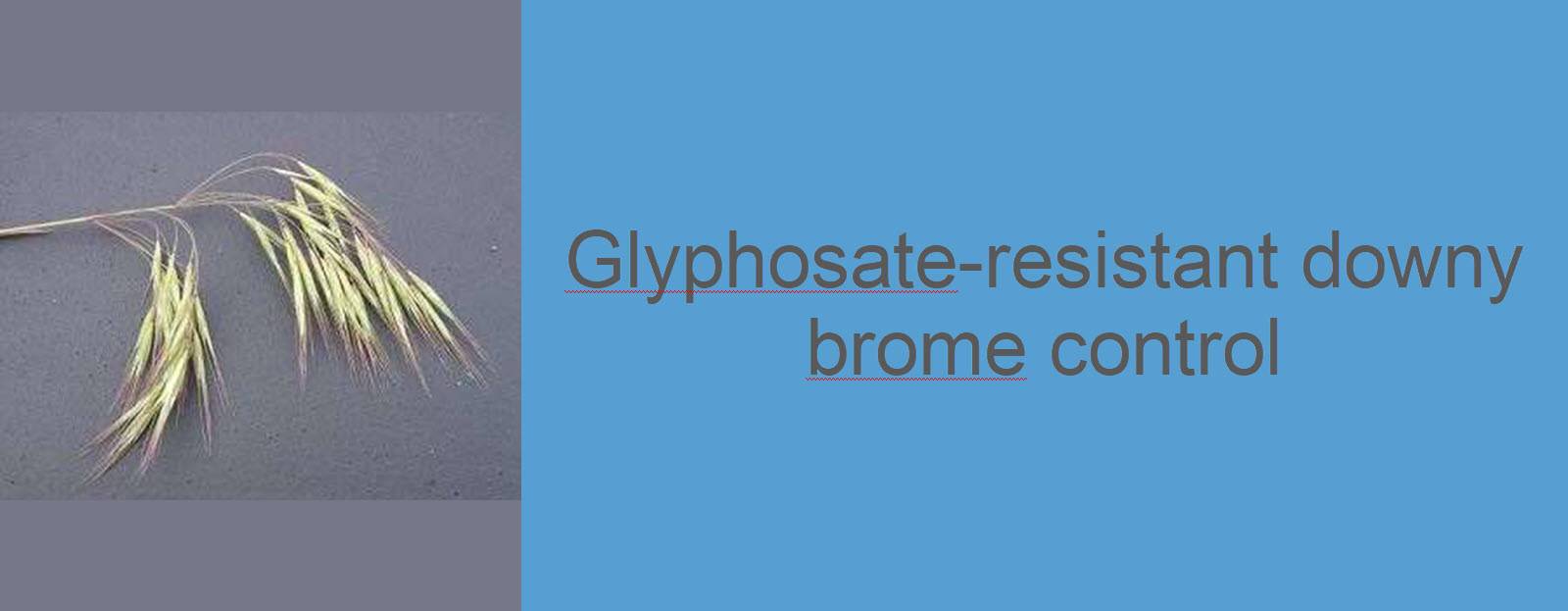
Article from the Canadian Agronomist
Quizalofop alone or in combination with imazamox, imazamox + bentazon, or imazamox/imazethapyr, and glufosinate mixed with clethodim resulted in more than 80% visible control, plant mortality, and reduction in biomass of glyphosate-resistant downy brome 21 days after treatment.
Glyphosate-resistant downy brome was confirmed in a southern Alberta field near Taber in 2021. Seedlings from the population survived label rates of 900 g ae/ha under controlled-environment conditions, and had up to 11.9-fold resistance to glyphosate in dose response bioassays.
Research was conducted to determine which alternative post-emergence (POST) herbicides and herbicide mixtures effectively manage glyphosate-resistant downy brome at the seedling stage; and whether the response of glyphosate-resistant downy brome to POST herbicides was similar to that of a glyphosate-susceptible population.
Glyphosate-resistant and susceptible seed was collected from mature plants in 2021. The seed was planted into greenhouse pots and thinned to 15 plants per pot. Twenty different herbicide treatments were applied at recommended label rates. These herbicides were based on their registration for either suppression or control of downy or Japanese brome in Alberta. Herbicides were applied at the 2-leaf stage of downy brome.
Herbicide treatments evaluated for management of glyphosate-resistant and glyphosate-susceptible downy brome post-emergence
|
|||||||||||||||||||||||||||||||||||||||||||||||||||||||||||||||
| *Not registered |
Visible control was assessed at 7 and 21 days after treatment (DAT), and plant survival and biomass were determined at 21 DAT.
Post-emergent options exist
When applied to glyphosate-resistant downy brome, glyphosate applied at 900 g ae/ha (0.67 l/ac Roundup WeatherMAX) had very poor or no control at 7 and 21 DAT, and there was 100% survival at 21 DAT. This compared to 100% control of glyphosate-susceptible downy brome 21 DAT.
Six herbicide treatments provided greater than 80% visible control, plant mortality and reduction in weed biomass 21 DAT for glyphosate-resistant downy brome. These treatments had 4% or less plant survival 21 DAT under the greenhouse conditions. Note, though, that control levels under field conditions might not be as high because of less-ideal growing environment.
Treatments providing greater than 80% control
| Herbicide | Trade Name | Herbicide Group | GR downy brome visible control 21 DAT (%) | Registered crops* |
| Quizalofop | Assure II | 1 | 97 | Canola, flax, sunflower, and many pulses |
| Imazamox + Bentazon + Quizalofop | MPower Anaconda | 2+6+1 | 94 | Field pea |
| Imazamox + Quizalofop | Solo ADV + Assure II | 2+1 | 93 | Manufacturer supported on Group 2 tolerant lentils |
| Imazamox/Imazethapyr + Quizalofop |
Odyssey WDG + Assure II | 2/2+1 | 93 | Manufacturer supported on Group 2 tolerant lentils, field pea and soybean |
| Glufosinate + Clethodim | Liberty 150 SN + Centurion | 10+1 | 88 | Liberty Link canola; Glufosinate-tolerant canola |
| Glufosinate + Tiafenacil | Liberty 150 SN + Tiafenacil 70WG | 10+14 | 98 | Not registered |
*Not all crops registered at all rates.
Adapted from Alberta 2023 Crop Protection Guide. Always read and follow label directions. No cross-resistance to other herbicides applied post-emergent was observed in the glyphosate-resistant population.
The research identified several viable post-emergent options for glyphosate-resistant downy brome control in canola, oilseed and pulse crops, but cereals are a weak spot in control. Pyroxsulam is registered for post-emergent application in spring wheat, durum wheat and winter wheat in western Canada. Imazamox is the grass component of Altitude FX 3 registered for use in imidazolinone-resistant wheat. Both imazamox and the high rate of pyroxsulam reduced downy brome biomass fresh weight >80%, but resulted in suppression (60-80% control) based on visual estimates because a high percentage of plants remained alive 21 DAT.
Downy brome infestations spread mainly by seed, and it has a relatively short seedbank persistence of 2 to 5 years. This provides an opportunity to help control the seedbank and spread of glyphosate-resistant downy brome if effective control is implemented.
Previous research by Johnson et al (2018) found that pre-plant pyroxasulfone-containing herbicides, (Focus and Fierce herbicides) provided effective control of both Japanese and downy brome, and consistently maintained optimum winter wheat yield. Further research is need to determine which pre-emergence herbicides could be used in a herbicide layering strategy in wheat, oilseeds and pulse crops to target glyphosate-resistant downy brome.
Funding for this research was provided by the Governments of Manitoba and Canada through the Canadian Agricultural Partnership, the Alberta Wheat Commission, Manitoba Canola Growers Association, Manitoba Crop Alliance, Manitoba Pulse & Soybean Growers, Saskatchewan Ministry of Agriculture, Saskatchewan Wheat Development Commission, and Western Grains Research Foundation. In addition, support was provided by Agriculture and Agri-Food Canada through the ongoing efforts of the Prairie Biovigilance Network.
Geddes, C., & Pittman, M. (2023). Glyphosate-resistant downy brome (Bromus tectorum) control using alternative herbicides applied postemergence. Weed Technology, 1-17. https://doi.org/10.1017/wet.2023.13 Johnson, E., Wang, Z., Geddes, C., Coles, K., Hamman, B., & Beres, B. (2018). Pyroxasulfone Is Effective for Management of Bromus spp. in Winter Wheat in Western Canada. Weed Technology, 32(6), 739-748.

